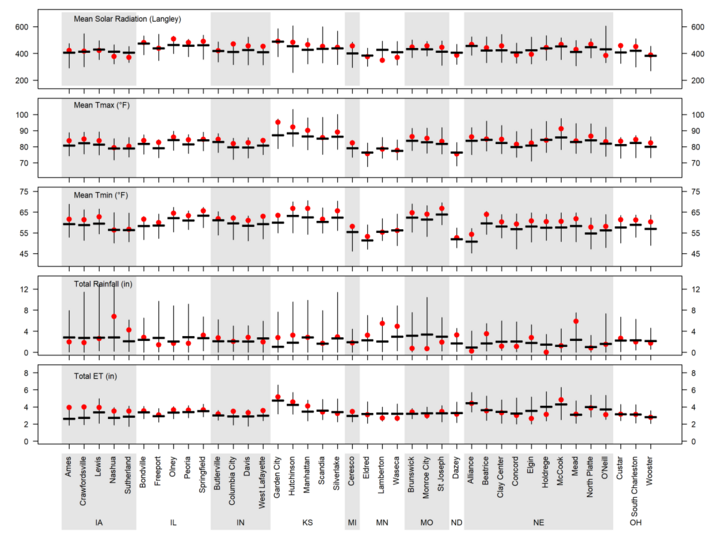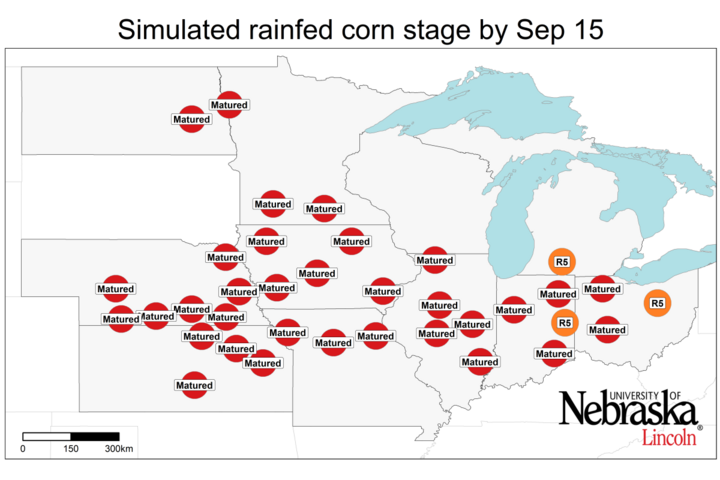This is the last article in a series that summarizes the simulated crop stages and yield forecasts across the Corn Belt. To evaluate, in “real-time,” the impact of this season’s weather on corn yield and its spatial variability across the Corn Belt, simulations of 2021 real-time crop stage were performed for 40 locations across the US Corn Belt using the UNL Hybrid-Maize crop model; the data can be downloaded here. Details on the UNL Hybrid-Maize crop model and the underpinning methodology to simulate phenology and forecast end-of-season yields is described in a previous article.
Crop Stages and Weather Conditions During the Last Three Weeks
Corn has reached black layer at most locations of the Corn Belt, except for two irrigated sites in NE and three rainfed sites in the eastern fringe of the region (Figure 2). During the last three weeks, most sites across the Corn Belt exhibited above-normal temperature together with near-normal rainfall records. A few sites in southern NE and MO also presented above-normal night temperatures but below-normal rainfall. In contrast, sites in ND, MN, and northern IA, presented near-normal temperature and above-normal rainfall. A summary of weather conditions during the past three weeks is shown in Figure 1.



Near or Below Average Yields in Irrigated Corn
Forecasted end-of-season irrigated yields are shown in Figure 3 and 4. About 70% of the irrigated sites (9 out of 13) exhibited near-average yields. Compared with our previous forecast, above-average temperature during the past three weeks increased the number of sites with below-average yield potential from one to four. With the exception of two sites located in western NE (Alliance and North Platte), the irrigated maize yield potential forecasted for the current 2021 season is 10% lower, on average, compared to that in the previous (2020) season.
Rainfed Corn: Yield Potential Is Highly Variable Across Rainfed Sites
Forecasted end-of-season yields for rainfed corn indicate above-average yields at only 20% (7 out of 36) of the sites, and these were mostly located in the southern fringe of the region (eastern KS, MO, and southern IL) and MI (Figure 3 and 4). In contrast, 45% of the sites (16 out of 36) exhibited below-average yields. These sites with below-average yield were located in ND, MN, NE, IA, and northern IL. The remaining 13 sites, mostly located in the eastern part of the Corn Belt (central IL, IN, and OH), showed a high probability of near-average yield. Overall, this year’ scenario looks a bit more pessimistic compared with last year forecast. Half of the rainfed sites exhibited a decrease in yield potential that was larger than 5% compared to the 2020 season, especially in ND, MN, southern NE, and northern KS. In contrast, 25% of the sites improved yields by at least 5%, compared with the 2020 season, especially in eastern MO, southern IL, eastern NE, and western IA.




Conclusions
In line with our previous reports, our forecasted yield potential this season seems to be 10% below the historical average. Our forecast suggests a near-average year for most irrigated sites although one third of the sites can expect yields to be below the historical average. For rainfed corn, the scenario is diverse across regions. Most sites in the eastern part of the Corn Belt have a high probability of near-average yields. Above-average yield is expected at seven locations in KS, MO, MI, and IL. In contrast, 13 sites located in northern and western fringes of the Corn Belt exhibit a high probability of below-average yields. Note that these forecasts do not take into consideration problems with stand emergence, hail/flooding damage, replanting situations, disease, or nitrate leaching. In fields negatively affected by these constraints, actual yields will be lower than estimates provided here. It is important to keep in mind that yield forecasts are not field specific and, instead, represent an estimate of average on-farm yield for a given location and surrounding area in absence of the yield-reducing factors mentioned here. Likewise, crop stages and forecasted yields will deviate from those reported here in fields with planting dates or hybrid maturities that differ markedly from those used as the basis for these forecasts.
